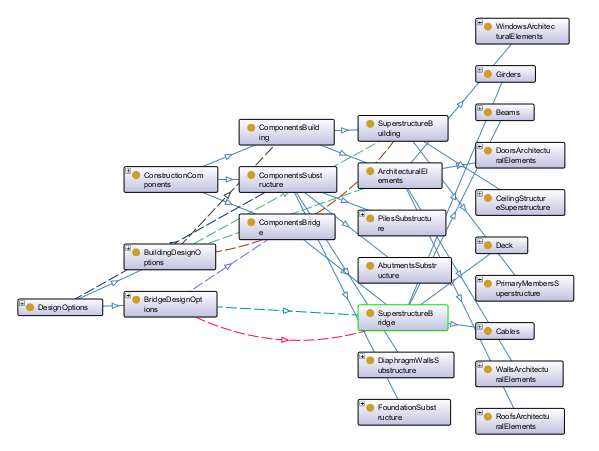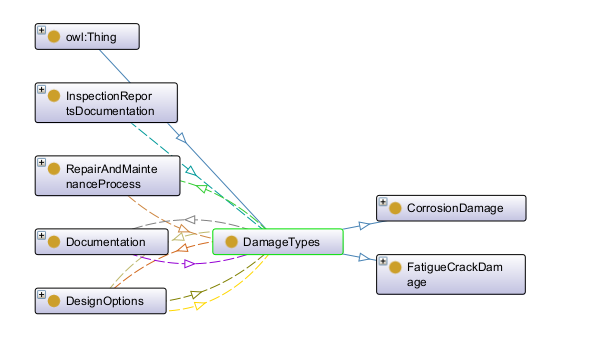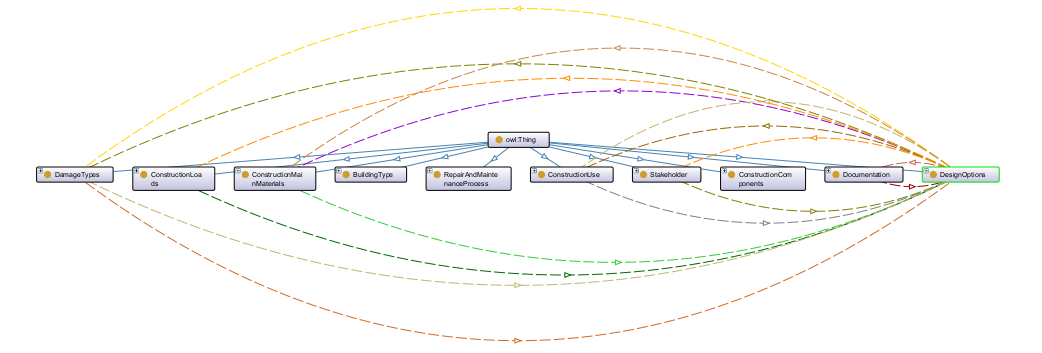The integration of ontological models was a crucial step in establishing a logically structured and semantically coherent representation of the four civil systems within the urban framework. While the building models primarily addressed architectural and design aspects, the bridge model focused on repair and maintenance. By combining insights from these models, a more comprehensive ontology was developed, extending far beyond the scope of the initial ontologies. This ontology offers a systematic framework for managing engineering knowledge, specifically addressing the various damage types that can affect building and bridge components.
Ontology Integration Approach
Unification of Core Concepts
The first key aspect of the combined ontology was to provide a structured framework that categorizes and defines relationships between architectural and structural components. Since the three building ontologies shared many properties, they were largely unified under parent classes. The resulting components are illustrated in Figure 1. The bridge from the fourth ontology is categorized separately and has been expanded with multiple components to enhance its adaptability within the new model.
Figure 1: Implemented Construction Components
As a second step, the maintenance process was incorporated to assign damage and repair tasks to these construction components. With a comprehensive dataset covering various building types and bridges, the ontology’s maintenance functionality now enables users to efficiently organize and manage the maintenance and repair processes for both buildings and bridges.
Figure 2: Damage types and relationships
Parameter Integration
Shared parameters between building and bridge designs, such as materials, damage types, and damage documentation, were consolidated and made applicable to both structures. Meanwhile, construction uses and load classifications were distinctly categorized for buildings and bridges. To retain the original building type classifications from the initial ontologies, a parent class, BuildingType, was created with High-Rise Building and Residential Building as its subclasses.
Figure 3: top-level classes
Design Options
The ontology provides a tool to track the damage and repair process of a building component. To demonstrate the usability, four design options were made. All of them are based on the individual models.
- Truss Bridge with a fatigue crack in a deck element
- High-Rise Building with corrosion dammage in a Beam
- Residential Building with a corrosion dammage in a shallow foundation
- High-Rise building with a Tube structure with a fatigue crack in the ceiling structure.
Each design option represents a distinct challenge. This versatility ensures that the ontology can be applied to a wide range of civil engineering contexts, improving decision-making and facilitating more effective maintenance strategies.
Final Ontological Structure
The final integrated ontology provides:
✅ A streamlined hierarchy that classifies all structures appropriately.
✅ Cross-system relationships that ensure connectivity between the bridge and buildings.
✅ A unified maintenance strategy, extending beyond the bridge to the high-rises and residential building.
✅ A parametric-friendly structure, ensuring that ontology-driven constraints guide the parametric model integration.
This ontology-first approach ensures that our integrated parametric model operates within a robust, semantically enriched framework, allowing for improved decision-making, automation, and long-term system adaptability.


